College of Physical and Engineering Science (University of Guelph)
The College of Physical and Engineering Science (CPES) is one of the colleges at the University of Guelph located in Guelph, Ontario, Canada. In 1989, the Ontario Agricultural College (OAC) School of Engineering was merged with the College of Physical Sciences to become the CPES.
The College of Physical and Engineering Science offers both undergraduate and graduate degrees in five disciplines. They are Chemistry, Computing and Information Science, Engineering, Mathematics and Statistics, and Physics.[1] These five disciplines follow a three to five year structure with some programs including a co-op option. The dean of the college is Dr. Anthony Vannelli, and is further administered by ten personnel.[2]
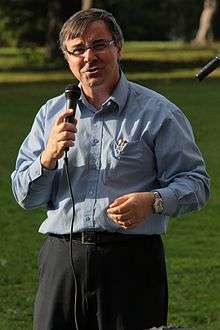
History of College
The College of Physical and Engineering Sciences was created in 1989 as a result of a number of significant department merges and divisions within the University of Guelph. The Ontario School of Agriculture (later changed to the Ontario Agriculture College and Experimental Farm in 1880.[3] The Macdonald Institute and The Ontario Veterinary College were all created in 1874, 1903 and 1922 respectively and were subsequently merged under the University of Guelph Act of 1964 forming a single institution. Five years later these three departments were divided into three new colleges being the College of Arts, the College of Physical Sciences and the College Social Sciences, but not before the Macdonald Institute formally became the College of Family and Consumer Studies. Then, in 1971, the College of Biological Science was constituted from the College of Physical Education, OAC’s Department of Nutrition and parts of OAC’s departments of Botany, Microbiology and Zoology. Finally in 1989 OAC's school of Engineering was merged with the College of Physical Sciences to become the College of Physical and Engineering Sciences.[4]
Engineering has been taught at the University of Guelph since 1984. The first building constructed was towards agricultural mechanics in 1905 and measured 146 ft by 64 ft. The program was developed in the early twenties through the Farm Power short courses and consultation services offered by the department. The Agricultural Engineering Department was created in 1928 with the incorporation of the Physics, Farm Mechanics and Manual Training departments. After World War I there was an increase in the mechanization of Ontario farms and an agricultural engineering option was planned to meet this development. Thus, in 1946, the first class of twelve enrolled in the new Agricultural Mechanics Option and in 1948 were awarded a Bachelor of Science in Agriculture (BSA).
With time, the University expanded its programs and in 1954 students had the option of completing an additional year in Mechanical Engineering at the University of Toronto earning them a Bachelor of Applied Science (B.A.Sc.) degree along with their BSA degree. Furthermore, in 1957 University of Guelph students had the option of completing Civil Engineering at the University of Toronto. In addition, 1957 was also the year the Department of Agricultural Engineering changed its name to the Department of Engineering Science.[2]
In 1965, the Senate of the University of Guelph established The School of Agricultural Engineering further adding the B.Sc. (Eng) degree. Students in their final year had the option of choosing Agricultural Engineering, Biological Engineering or Water Resources Engineering as one of their majors. This new undergraduate program began in the fall semester of 1969 and was fully operational in 1972-73 school years, after being certified by the Canadian Accreditation Board of the Canadian Council of Professional Engineers. The program later expanded in the 1980s and included optional minors in Food Engineering and Environmental Engineering. Then, in 1984, a cooperative educational program was created for individuals with outstanding rankings.[2]
In 2008, the University of Guelph launched Canada's first full-fledged Nanoscience major, which is provided by CPES. CPES also launched a new Mechanical Engineering program in 2009. The new program allows students to specialize in wind and solar energy, mechatronics, food and beverage engineering, biomechanics and prosthetics manufacturing or to do a combination depending on their interests.[5] Additionally in 2010, CPES has added two more programs, Biomedical Engineering and Computer Engineering.[6][7]
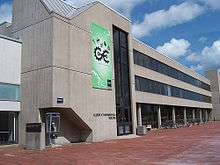
In addition, on May 31, 2010, the University of Guelph Senate approved a proposal to create the faculty of Physical and Mathematical Sciences which will include the CPES departments of Physics, Chemistry, and Mathematics & Statistics. Furthermore, the Department of Computing and Information Science (CIS) will be renamed the School of Computer Science, falling within the Faculty of Engineering and Computer Sciences.[8]
Albert A. Thornbrough Building
The Albert A. Thornbrough building was opened on June 23, 1973. It was named after Albert A. Thornbrough, president of Massey-Ferguson Ltd., and Vice-Chairman of the University Board of Directors and Chairman of the University Finance Committee from 1968 to 1973. Massey-Ferguson Ltd., a major agricultural equipment manufacturer donated $750,000 toward the $2,000,000 building costs.[2]
In 2009, the School of Engineering embarked on a $22,300,000 expansion project to the Albert A. Thornbrough Building. Phase 1 of the project added 50,000 sq.ft. of space with a building connection to the Richards Building. This also includes an L-shaped addition to the southeast corner of Thornbrough to accommodate the School’s immediate requirement for shop space, labs and design studios for the new Mechanical Engineering program which has already commenced. Phase 1 also includes a four-storey addition connecting Thornbrough with Richards at Branion Square. This addition, supporting all three areas of growth identified above, adds computer labs, student presentation spaces, faculty offices and a unique rooftop sustainability research space complete with an associated support lab below. Phase 2 of the project renovated 52,000 sq.ft. of space in both the Richards and Thornbrough buildings. This achieved the greatest utility of existing facilities by consolidating the dry lab and faculty spaces in the Richards Building, which were to be gutted and retrofitted, while the core of the Thornbrough Building is reconfigured as a unified wet lab area. These major renovations accommodate the accumulating need for research and teaching spaces, design studios, and faculty offices as the expansion of the School of Engineering continues to unfold. In 2011, the expansion project to the Albert A. Thornbrough building is complete.[9]
Departments & Programs
Department of Chemistry
The Department of Chemistry houses 20 faculty members active in the fields of analytical, physical, theoretical, organic and inorganic chemistry. Paul Rowntree is the chair of the department and faculty members are located in both the McNaughton Building[10] and the Science Complex.[11]
Undergraduate programs contain a co-op option, giving students the opportunity to apply their education outside of the classroom.[12] For graduate studies, the University of Guelph has a partnership with the University of Waterloo, which is highly recognized across Canada as one of the best chemistry graduate programs in the country.[13]
Undergraduate Programs offered
Biological and Pharmaceutical Chemistry B.Sc. (Co-op available)
- For students who wish to maintain a strong chemistry core while being able to branch into biological and pharmaceutical chemistry, applied pharmacology, physics, or toxicology.[14]
Chemistry B.Sc. (Co-op available)
- Studying how molecules behave, and creating new molecules to analyze.[15]
Chemical Physics B.Sc. (Co-op available) Offered jointly with the Department of Physics
- A well-rounded program marked by the combination of chemistry and physics.[16]
Nanoscience B.Sc. (Co-op available) Offered jointly with the Department of Physics
- Program includes research based curriculum, small classes and exciting career opportunities in this new fast growing field [17]
Toxicology B.Sc. (Co-op available)
- An interdisciplinary program with a strong focus on chemistry that also encompasses fields of study such as ecosystem health, including water, air and soil quality, plant health, microbes, and insects, sustainable agriculture and human and animal health.[18]
Graduate Programs Offered
- There are combined graduate programs offered between the University of Guelph and the University of Waterloo with close to 60 graduate students in the Department of Chemistry specializing in chemistry and biochemistry.[19]
School of Computer Science (SoCS)
The School is located in the Reynolds building,[20] where 19 faculty reside. The director of the School of Computer Science is Dr. Stefan C. Kremer. The School is committed to first rate research and innovation within the field of computer science. They offer a wide variety of co-op programs to give students a head start on their careers.[21]
Undergraduate Programs offered
Computer Science B.Comp. (Co-op available)
- Providing a solid foundation in computing with a focus on software, hardware and theory.
Software Engineering B.Comp. (Co-op available)
- A program aimed at developing professional and teamwork skills with a focus on the development and design of software. Currently not accredited as an engineering program.
Graduate Programs Offered
- The School of Computer Science offers both MSc and PhD programs in the fields of applied modeling, artificial intelligence, distributed computing and human computer interactions.[22]
Department of Mathematics and Statistics
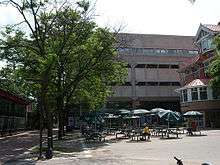
The department is located in the McNaughton building with over 20 faculty members and O.B. Allen is the chair of department. Chris Bauch[23] is a member of the department who was featured at the TEDxGuelphU conference where he gave a talk on infectious diseases, vaccines and statistics.[24] Co-op programs are offered for some majors.
Undergraduate Programs offered:[25]
Mathematics B.A., B.Sc.,[26]
- For the math-minded, or those interested in studying pure mathematics.
Statistics B.A., B.Sc., Diploma—Applied Statistics
- A math base with a focus on modern statistical methods.
Applied Mathematics and Statistics B.Sc. (Co-op only)[27]
- A math and statistics education with the option of applying concepts in a co-op position.
Graduate Programs Offered
- There are nearly 50 graduate and PhD students specializing in dynamical systems, mathematical biology, numerical analysis and operations research and applied statistics.[28] Also, some faculty members participate in an interdepartmental graduate program in Biophysics.[29]
Department of Physics
The department of physics consists of 18 faculty members located in the MacNaughton building. In addition, the department has its own observatory located on top of the building. The telescope has four eyepieces and has a focal length of 3910 mm.[30] Faculty members collaborate with many different institutions such as the Perimeter Institute and TRIUMF.[31] The department also features numerous seminars and events on topics such as fusion energy, particle colliders and many more. Faculty member Ralf Gellert is a lead scientist for the Alpha particle X-ray spectrometer (APXS) that is on board the Mars Exploration Rovers (MER).
Undergraduate Programs offered:[32]
Physics B.Sc. (Co-op available)
- Program focuses on covering fundamentals of physics such as electromagnetism, quantum physics, subatomic particles, and mechanics.
Nanoscience B.Sc. Offered jointly with the Department of Chemistry
- Program includes research based curriculum, small classes and exciting career opportunities in this new fast growing field.[33]
Theoretical Physics B.Sc.
- Designed for those students who value taking additional mathematics courses in order to prepare them to work in the modern field of theoretical physics.
Chemical Physics B.Sc. (Co-op available)
- Major focuses on quantum mechanical basis of molecular structure and materials science.
Biophysics B.Sc. (Co-op available)
- This program includes unique disciplines such as molecular biology, biochemistry and the study of ecosystems.
Graduate Programs Offered
- The department offers a combined graduate program in physics alongside the University of Waterloo through the Guelph-Waterloo Physics Institute.[34] The second option is the interdepartmental Graduate Program in Biophysics.[35] There are about 40 graduate and PhD students enrolled in graduate programs within the physics department.
School of Engineering
Guelph's engineering programs focus on applying theory into practice by emphasizing engineering design projects. The department is located in the Thornbrough building,[36] which holds over 43 faculty members. School of Engineering. School of Engineering Faculty. Retrieved October 28, 2013, from http://www.uoguelph.ca/engineering/faculty. There are seven different majors with a co-op option for each of them. An additional option, Undeclared Entrance, is also available since students take the same introductory courses in their first year.[37] The University of Guelph offers a wide variety of support to engineering students via counseling, cluster living in residence, and peer helpers. Guelph's engineering programs focus on applying theory in practice, and thus, by the end of their undergraduate degree students will have completed at least six engineering design projects. Guelph emphasizes that enrollment in any of the seven engineering programs allows students to become very familiar with their peers and teachers due to the amount of interaction between them.
The School of Engineering is also the home of the Guelph Engineering Society,[38] the largest student organization operated under the College of Physical and Engineering Sciences. A variety of other student groups are also available to undergraduate engineering students, including but not limited to: the BioEngineering Club, Engineers Without Borders,[39] Gryphon Racing[40] (Formula SAE Team), the Guelph Robotics Team,[41] and Women in Science and Engineering.[42] As well as student clubs, students can associate with Research Groups such as: the BioNano Laboratory, Advance Robotics and Intelligent Systems (ARIS) Lab, the Ontario Rural Wastewater Centre (ORWC), or the Urban Systems Environmental Design (USED) Centre.[43]
Undergraduate Programs offered
Biological B.Eng.
- For those who want to enhance human, animal and plant life by applying engineering principles to controlling biological processes. Areas of interest include bioprocess development and design, food engineering and biomedical applications.[44]
Biomedical B.Eng.
- A program that focuses on designing future medical instruments and mechanical implants by applying engineering principles to medicine. Areas of interest include biomechanics, Biosignal processing and instrumentation and Pharmaceuticals.[45]
Computer B.Eng.
- Computer engineers focus on artificial intelligence and robotics, software, microsystems design and electronic design automation.[46]
Engineering Systems and Computing B.Eng.
- A multidisciplinary field that combines principles of general engineering along with strengths of computer science.[47]
Environmental B.Eng.
- This program focuses on the ways engineering principles can help to minimize the impact of humans on the environment.[48]
Mechanical B.Eng.
- Students can specialize in mechatronics, wind and solar energy, manufacturing, and many more.[49]
Water Resources B.Eng.
- Program focuses on hydrology, environmental science, meteorology, geology, conservation and resources management in order to address modern concerns surrounding water.[50]
Undeclared Entrance.
- This option allows students to decide which field they would like to focus on after completing their first year at the University.[51]
Graduate Programs Offered
- The department offers MEng programs in Water Resources Engineering, Engineering Systems and Computing, Environmental Engineering, Biological Engineering.[52] There are also PhD and MASc options in those disciplines.[53] The Graduate Engineering Society represents graduate engineering students by facilitating social events as well as providing trivial services such as photocopying and printing.[54]
Math & Stats Learning Centre
The Mathematics & Statistics Department within the CPES assists students by providing a centre in which tutoring is available for various 1000 & 2000 level Math & Stats courses.[55]
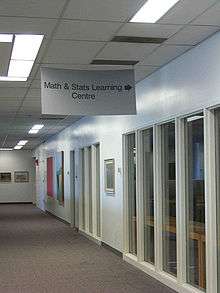
Tutors are available in the fall and winter semester to work with drop-in students.[56] The center is located in the McLaughlin Library, on the third floor and the hours vary depending on the time of year.[57]
Senior undergraduate & graduate students are welcome to work at the Learning Centre for wages. They can apply at the Mathematics and Statistics office in the MacNaughton Building.[58]
The Learning Centre also posts Self-Study Modules on its website which include problems such as Exponents & Logs, Trigonometry, Quadratics, Graphs, Equations and Lines. Students or anyone interested have the ability to attempt these modules at their leisure.[55]
The website also hosts access to a repository of modules covering various topics to assist all University students with improving their numeracy and quantitative reasoning abilities. The Numeracy and Quantitative Reasoning Initiative, which began in 2005, was responsible for the creation of the Repository.[59] The University of Guelph Library & Learning Commons, the Data Resource Centre (DRC), the Teaching Support Services (TSS) and the Computing and Communications Services work alongside the Department of Mathematics and Statistics to maintain the success of the Repository.[60] Subjects include Percentages & Percentiles, Nominal, z-scores, Measures of Central Tendency, and t-tests, with the option to search the Repository for various topics.[61]
Students are encouraged to reach out to the Learning Centre and to seek assistance through the Numeracy and Quantitative Reasoning Repository. Further help for Math & Stats students can be found through seminars held periodically in sections such as Colloquium Series, Thesis/Project Presentation, Applied Analysis, Biomathematics & Biostatistics, Operations Research, Quantum Information & Geometric Statistics, and Computational Statistics.[62]
A program also exists through the Supported Learning Groups (SLG) which helps Math & Stats students with MATH 1080 (Elements of Calculus I) and STAT 2040 (Statistics I) by providing sessions led by Peer Helpers. Students are given the opportunity to work on course concepts, program vocabulary and are thereafter able to test themselves.[63]
Student Life
Extracurricular
The college encourages students to get involved in their respective fields of study by offering things such as social networking in the Computer Science department and job opportunities to undergraduate & graduate students. These are just some examples of ways students can get involved.[64] Many of the people on the Gryphon Racing team, a student run club that builds an open-wheeled racecar each year, are Engineer majors.[65] Nanoscience students involved in the Nanoclub participated in NanoDay at the Museum at The Waterloo Regional Children's Museum.[66]
The college also hosts various events involving high-school students such as the School of Engineering's WindEng design competition and Roboticon, which is held by the School of Computer Science.[67] CPES was instrumental in creating the Guelph Science Olympics in 2009 with involvement from the College of Biological Science and the Ontario Agricultural College.[68]
CPES Student Council
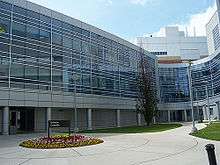
The CPES Student Council (CPESSC) is a student run organization within the CPES that brings the college students together for social activities and also allows their voice to be heard by the college, the Alumni Association and the university community.[69] The hub of CPES is in the Science Complex, where weekly meetings occur and offices of council members reside. These elected positions include a President, VP Internal, VP Social, VP Finances, VP Operations and Chairperson.[70]
CPESSC also has the duty to support registered academic interest groups within the college. Each club has the right to vote on CPESSC issues during their weekly meetings.[71] The clubs currently registered with the CPESSC are:[71]
- Astronomy Club
- Bachelor of Arts & Science Student Association
- Biological Engineering Club
- Chemistry & Biochemistry Club
- Engineering Society
- Environmental Water Resource Association
- Guelph Innovation Society
- Math & Stats Club
- Nanoscience Club
- Physics Club
- Society of Computing & Information Science
- Women in Science & Engineering
- Toxicology Student Association
See also
- University of Guelph
- Guelph, Ontario
- List of Ontario Universities
- University of Guelph Arboretum
- University of Guelph-Humber
- Guelph Gryphons
- Central Student Association
- The Ontarion
References
- ↑ University of Guelph. (2009). College of physical & engineering science. Retrieved from http://www.cpes.uoguelph.ca/
- 1 2 3 4 College of Physical & Engineering Science. (2013). Dean's Office Directory. Retrieved from https://www.uoguelph.ca/cpes/stafflist
- ↑ Ontario Agricultural College, University of Guelph. (2008). About Guelph . Retrieved from http://www.oac.uoguelph.ca/about/overview.cfm
- ↑ College of Arts, University of Guelph. (n.d.). About Guelph. Retrieved from http://arts.uoguelph.ca/prospective-students/about-guelph/
- ↑ University of Guelph. Mechanical engineering. Retrieved from https://admission.uoguelph.ca/template.aspx?SiteID=e02ad637-556b-443e-99c8-5458b56490f6
- ↑ University of Guelph. Biomedical engineering. Retrieved from http://www.uoguelph.ca/engineering/undergrad-biomedical-overview
- ↑ University of Guelph. Computer engineering. Retrieved from http://www.uoguelph.ca/engineering/undergrad-computer-engineering
- ↑ Communications and Public Affairs, University of Guelph. (2010). CPES creates a new faculty, CIS changes its name. Retrieved from http://atguelph.uoguelph.ca/2010/06/cpes-creates-a-new-faculty-cis-changes-its-name/
- ↑ University of Guelph (2010). School of Engineering Expansion. Retrieved from http://www.soe.uoguelph.ca/webfiles/expansion/
- ↑ University of Guelph (2010). McNaughton Building. Retrieved July 21, 2010, from http://www.uoguelph.ca/campus/map/macnaughton/
- ↑ University of Guelph (2010). Science Complex. Retrieved July 21, 2010, from http://www.uoguelph.ca/campus/map/sciencecomplex/ University of Guelph (2010). Department of Chemistry. Retrieved July 21, 2010, from http://www.chemistry.uoguelph.ca/cgi-bin/ucon.exe?ac=v_page&pa=IPP71N
- ↑ Undergraduate Programs. (2007). Department of Chemistry. Retrieved June 27, 2010, from http://www.chemistry.uoguelph.ca/academic/
- ↑ Waterloo Centre for Graduate Work in Chemistry and Biochemistry. (2007). Waterloo Centre for Graduate Work in Chemistry and Biochemistry. Retrieved June 29, 2010, from http://www.gwc2.on.ca
- ↑ Waterloo Centre for Graduate Work in Chemistry and Biochemistry. (2007). Waterloo Centre for Graduate Work in Chemistry and Biochemistry. Retrieved June 29, 2010, from http://www.gwc2.on.ca/
- ↑ Undergraduate Programs. (2007). University of Guelph. Retrieved June 29, 2010, from http://www.chemistry.uoguelph.ca/academic/bsccoop.html
- ↑ Undergraduate Programs. (2007). University of Guelph. Retrieved June 29, 2010, from http://www.chemistry.uoguelph.ca/academic/chemphys.html
- ↑ Undergraduate Programs. (2007). University of Guelph. Retrieved June 29, 2010, from http://www.nano.uoguelph.ca/cgi-bin/ucon.exe?ac=v_page&pa=KIHHFO
- ↑ Undergraduate Programs. (2007). University of Guelph. Retrieved June 29, 2010, from http://www.uoguelph.ca/toxicology/
- ↑ University of Guelph (2010). Department of Chemistry. Personnel. Retrieved July 21, 2010, from http://www.chemistry.uoguelph.ca/cgi-bin/ucon.exe?ac=v_page&pa=J5R5YF
- ↑ University of Guelph (2010). Reynolds Building. Retrieved July 21, 2010, from http://www.uoguelph.ca/campus/map/reynolds/
- ↑ University of Guelph. (2010). School of Computer Science. Retrieved June 29, 2010, from http://www.cis.uoguelph.ca
- ↑ University of Guelph (2010).Mathematics and Statistics Graduate Calendar 2010-2011. Retrieved July 21, 2010, from http://www.uoguelph.ca/registrar/calendars/graduate/current/pdffiles/cis.pdf
- ↑ Chris Bauch (2010). Retrieved July 21, 2010, from http://www.uoguelph.ca/~cbauch/
- ↑ TEDxGuelphU (2010). Speakers. Retrieved July 21, 2010, from http://tedxguelphu.com/?page_id=20
- ↑ Undergraduate Program. (2010). Department of Mathematics & Statistics | University of Guelph. Retrieved June 29, 2010, from http://www.mathstat.uoguelph.ca/pages/contact
- ↑ University of Guelph (2010). 2010 -2011 Undergraduate Calendar. Mathematics (MATH). Retrieved July 21, 2010, from http://www.uoguelph.ca/registrar/calendars/undergraduate/current/c10/c10ba-math.shtml
- ↑ University of Guelph (2010). 2010 -2011 Undergraduate Calendar .Applied Mathematics and Statistics (Co-op) (APMS:C). Retrieved July 21, 2010, from http://www.uoguelph.ca/registrar/calendars/undergraduate/current/c10/c10bsc-apms-c.shtml
- ↑ University of Guelph (2010). Department of Mathematics & Statistics. Graduate Studies. Retrieved July 21, 2010, from http://www.mathstat.uoguelph.ca/pages/gradinfo/programs
- ↑ University of Guelph (2010). Biophysics Interdeparmental Group. Graduate Programs. Retrieved July 21, 2010, from http://biophysics.uoguelph.ca/central/graduate.htm
- ↑ Physics Observatory Telescope. (2009). Department of Physics. Retrieved June 29, 2010, from http://www.physics.uoguelph.ca/observatory.php
- ↑ General Information. (2009). Department of Physics. Retrieved June 29, 2010, from http://www.physics.uoguelph.ca/
- ↑ Information for Undergraduate Students. (2009). Department of Physics. Retrieved June 29, 2010, from http://www.physics.uoguelph.ca/undergrad-students.php
- ↑ University of Guelph. (2012). Nanoscience B.Sc. Program Retrieved October 28, 2013, from http://www.nano.uoguelph.ca/cgi-bin/ucon.exe?ac=v_page&pa=KIHHFO
- ↑ Guelph – Waterloo Physics Institute (2010). Retrieved July 21, 2010, from http://gwp.on.ca
- ↑ University of Guelph (2010). Biophysics Interdepartmental Group. Retrieved July 21, 2010, from http://biophysics.uoguelph.ca/
- ↑ University of Guelph (2010). Albert A. Thornbrough Building. Retrieved July 21, 2010, from http://www.uoguelph.ca/campus/map/thornbrough
- ↑ School of Engineering. (2012). Undeclared Entrance. Retrieved October 28, 2013, from http://www.uoguelph.ca/engineering/undeclared-entrance
- ↑ "Guelph Engineering Society".
- ↑ "Engineers Without Borders".
- ↑ "Gryphon Racing".
- ↑ "University of Guelph Robotics Team".
- ↑ "Beyond the Classroom Engineering Clubs".
- ↑ "Beyond the Classroom Engineering Research Groups".
- ↑ Biological Engineering. (2014). School of Engineering. Retrieved October 13, 2014, from http://www.uoguelph.ca/engineering/undergrad-biological-engineering
- ↑ Biomedical Engineering. (2014). School of Engineering. Retrieved October 13, 2014, from http://www.uoguelph.ca/engineering/undergrad-biomedical-engineering
- ↑ Computer Engineering. (2014). School of Engineering. Retrieved October 13, 2014, from http://www.uoguelph.ca/engineering/undergrad-computer-engineering
- ↑ Engineering Systems and Computing. (2014). School of Engineering. Retrieved October 13, 2014, from http://www.uoguelph.ca/engineering/undergrad-systems-engineering
- ↑ Environmental Engineering. (2014). School of Engineering. October 13, 2014, from http://www.uoguelph.ca/engineering/undergrad-environmental-engineering
- ↑ Mechanical Engineering. (2014). School of Engineering. Retrieved October 13, 2014, from http://www.uoguelph.ca/engineering/undergrad-mechanical-engineering
- ↑ Water Resources Engineering. (2014). School of Engineering. Retrieved October 13, 2014, from http://www.uoguelph.ca/engineering/undergrad-water-engineering
- ↑ Undeclared Entrance. (2014). School of Engineering. Retrieved October 13, 2014, from http://www.uoguelph.ca/engineering/undeclared-entrance
- ↑ School of Engineering (2012). MEng Program. Retrieved October 28, 2013, from http://www.uoguelph.ca/engineering/graduate-meng
- ↑ University of Guelph (2010). Graduate Students. Retrieved October 28, 2013, from http://www.uoguelph.ca/engineering/graduate
- ↑ University of Guelph (2013). Graduate Engineering Society. Retrieved October 28, 2013, from http://www.uoguelph.ca/~ges/ges/Welcome.html
- 1 2 University of Guelph: Department of Mathematics & Statistics. Facilities, Learning Centre. Retrieved from: http://www.mathstat.uoguelph.ca/pages/facilities/learning-centre
- ↑ University of Guelph: Department of Mathematics & Statistics. Facilities, Learning Center – Hours of Operation. Retrieved from: http://www.mathstat.uoguelph.ca/pages/facilities/learning-centre/schedule
- ↑ University of Guelph: Department of Mathematics & Statistics. Facilities, Learning Centre – Location. Retrieved from: http://www.mathstat.uoguelph.ca/pages/facilities/learning-centre/location
- ↑ University of Guelph: Department of Mathematics & Statistics. Facilities, Learning Centre – Employment. Retrieved from: http://www.mathstat.uoguelph.ca/pages/facilities/learning-centre/employment
- ↑ Learning Commons. (2006/09). Numeracy and Quantitative Reasoning Support Initiative. Retrieved from: http://www.uoguelph.ca/numeracy/numeracyBackground.pdf
- ↑ University of Guelph: Numeracy & Quantitative Reasoning. (2007). Collaboration. Retrieved from: http://www.uoguelph.ca/numeracy/committee.cfm
- ↑ University of Guelph: Numeracy & Quantitative Reasoning. (2007). Retrieved from: http://www.uoguelph.ca/numeracy/repository/index.cfm
- ↑ University of Guelph: Department of Mathematics & Statistics. Seminars. Retrieved from: http://www.mathstat.uoguelph.ca/seminars/
- ↑ University of Guelph: Numeracy & Quantitative Reasoning. (2007). More Help with Math, Stats, & Problem Solving. Retrieved from: http://www.uoguelph.ca/numeracy/moreHelp.cfm#top
- ↑ University of Guelph: School of Computer Science. (2010). Social Networking. Retrieved from: http://www.cis.uoguelph.ca/socialNetworking.php
- ↑ Gryphon Racing. Recruitment. Retrieved from: http://www.soe.uoguelph.ca/gryphonracing/sae_recruitment.html
- ↑ University of Guelph Nanoscience Retrieved from: http://www.nano.uoguelph.ca/cgi-bin/ucon.exe?ac=v_page&pa=KIHHFO
- ↑ University of Guelph: School of Engineering. Events. Retrieved from: http://www.soe.uoguelph.ca/events/index.html
- ↑ University of Guelph: Guelph Science Olympics. Retrieved from: http://www.scienceolympics.uoguelph.ca/
- ↑ Heppenstall, D. (2007). Home. CPESSC - CPES Student Council. Retrieved June 29, 2010, from http://www.uoguelph.ca/~cpessc/index.html
- ↑ Heppenstall, D. (2007). About Us. CPESSC - CPES Student Council. Retrieved June 29, 2010, from http://www.uoguelph.ca/~cpessc/about.html
- 1 2 Heppenstall, D. (2007). Our Organizations. CPESSC - CPES Student Council. Retrieved October 13, 2014, from http://www.uoguelph.ca/~cpessc/clubs.html
External links
- University of Guelph
- University of Guelph Athletics
- McLaughlin Library
- City of Guelph
- Guelph Downtown
- CPES Website
- CPES Student Council Website
- Roboticon